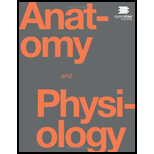
Watch this video (http://openstaxcollege.org/l/flexext) to learn more about the flexion and extension of the knee, as the femur both rolls and glides on the tibia to maintain stable contact between the bones in all knee positions. The patella glides along a groove on the anterior side of the distal femur. The collateral ligaments on the sides of the knee become tight in the fully extended position to help stabilize the knee. The posterior cruciate ligament supports the knee when flexed and the anterior cruciate ligament becomes tight when the knee comes into full extension to resist hyperextension. What are the ligaments that support the knee joint?
Want to see the full answer?
Check out a sample textbook solution
Chapter 9 Solutions
Anatomy & Physiology
Additional Science Textbook Solutions
College Physics
Anatomy & Physiology
Study Guide for Campbell Biology
Concepts of Genetics (12th Edition)
Human Physiology: An Integrated Approach (8th Edition)
Campbell Biology in Focus
- The movement during which the knees or elbows are bent to decrease the angle of the joints is known as _______________.arrow_forwardIf your foot is planted and immoveable (think lug-soled boot on a muddy trail), and you are hit from behind (think mountain biker out of control), which knee ligament is more likely to be torn...the anterior cruciate ligament or the posterior cruciate ligament? Explain your answer in detail, and in particular, how the impact affects the relative movements of femur and tibia and why the ligament you chose is stretched to the breaking point by this motion. Think and explain carefully...this stuff is confusing.arrow_forwardThe ‘screw-home’ movement in extension of the knee joint begins with tightening of thearrow_forward
- Which of the following compartments of the upper limb in the image provided act to flex or extend the joints that they cross?arrow_forwardanswer all parts What is the point of reference on the lower extremity for determining proximal versus distal position? What muscle would you guess inserts in the gluteal tuberosity? What does “linea aspera” mean? What bone do the medial and lateral condyles of the femur articulate with? What shape synovial joints is formed at the articulation of the femur with the patella? What is the function of the medial malleolus?arrow_forwardList the 2 major segments and 3 joints of the leg from proximal to distal.arrow_forward
- Watch this video (http://openstaxcollege.org/l/kneejoint1) to learn more about the anatomy of the kneejoint, including bones, joints, muscles, nerves, and bloodvessels. Which ligament of the knee keeps the tibia fromsliding too far forward in relation to the femur and whichligament keeps the tibia from sliding too far backward?arrow_forwardVisit this site (http://openstaxcollege.org/l/kneesurgery) to perform a virtual knee replacementsurgery. The prosthetic knee components must be properlyaligned to function properly. How is this alignmentensured?arrow_forwardOn the femur image below (posterior view), the arrow (marked with a star) is pointing to which feature? I Lesser Trochanter Patellar Grove Head O Linea Aspera O Greater Trochanterarrow_forward
- What type of movement is shown in the picture below: Rotation Circumduction O Plantar Flexion O Supinationarrow_forwardSit on the edge of a desk with your feet off the floor. Plantarflex your foot. Where is the effort? Where is the fulcrum? Where is the resistance? Which class of lever does the foot represent in plantar flexion?arrow_forwardIn thigh flexion at hip, which one is considered the origin? O Proximal end of psoas major Distal end of psoas major Proximal end of vastus lateralis Distal end of vastus lateralisarrow_forward
 Fundamentals of Sectional Anatomy: An Imaging App...BiologyISBN:9781133960867Author:Denise L. LazoPublisher:Cengage Learning
Fundamentals of Sectional Anatomy: An Imaging App...BiologyISBN:9781133960867Author:Denise L. LazoPublisher:Cengage Learning Medical Terminology for Health Professions, Spira...Health & NutritionISBN:9781305634350Author:Ann Ehrlich, Carol L. Schroeder, Laura Ehrlich, Katrina A. SchroederPublisher:Cengage Learning
Medical Terminology for Health Professions, Spira...Health & NutritionISBN:9781305634350Author:Ann Ehrlich, Carol L. Schroeder, Laura Ehrlich, Katrina A. SchroederPublisher:Cengage Learning

